Attractions · Europe · Going Out · Italy · Regions · Western Europe
The 9 most charming spots to visit in Umbria, Italy
Umbria isn’t much like the rest of the country. “Green Heart of Italy”, “Land of Saint Francis” are just some of the names often defining the enchanting region of Umbria. Umbria is the only region of central Italy that does not touch the sea, featuring landscapes very similar to those of Tuscany, but with more intimate dimensions. With fewer tourists, its cities have remained more authentic and less pretentious, this landlocked region in central Italy has art treasures to match anywhere on the peninsula.
 There are spots in Umbria that can touch your soul in a unique way, with arguably some of the greatest views in the world with splendours rarely seen. With shorter distances and less traffic, Umbria is an easier region to navigate between cities by car. So, if you decide to discover Umbria put these nine spots on your must-visit list.
Perugia
The capital of the region is three thousand years old, refounded by the Etruscans on a pre-existing Umbrian settlement. The city was one of the major hubs of the highest political role in Etruria. After the era of Roman domination, Perugia witnessed the moment of its greatest splendour between the 11th and 13th centuries. It is during this period that the majority of its most representative monuments and landmarks were built.
There are spots in Umbria that can touch your soul in a unique way, with arguably some of the greatest views in the world with splendours rarely seen. With shorter distances and less traffic, Umbria is an easier region to navigate between cities by car. So, if you decide to discover Umbria put these nine spots on your must-visit list.
Perugia
The capital of the region is three thousand years old, refounded by the Etruscans on a pre-existing Umbrian settlement. The city was one of the major hubs of the highest political role in Etruria. After the era of Roman domination, Perugia witnessed the moment of its greatest splendour between the 11th and 13th centuries. It is during this period that the majority of its most representative monuments and landmarks were built.
 The main itineraries for visitors include the historic centre set within the Etruscan walls, the Cathedral, and the frescoes by the Italian Renaissance painter Perugino. The underground Rocca Paolina, built during the mid-16th century under the Papal State, is truly spectacular. Not to be missed is also the National Gallery of Umbria, which houses the largest collection of Umbrian artworks including paintings of Il Pinturicchio and Il Perugino as well as other works of art dating back to the period that goes from the thirteenth to the nineteenth century.
Assisi
Standing there, you’ll actually feel frozen in time. Assisi is probably the most important artistic, cultural, and religious Italian destination. This charming medieval town features all the characteristics of an Umbrian borgo: perched on top of a hill overlooking the valley, of small dimensions and still keeping its authenticity over the centuries.
The main itineraries for visitors include the historic centre set within the Etruscan walls, the Cathedral, and the frescoes by the Italian Renaissance painter Perugino. The underground Rocca Paolina, built during the mid-16th century under the Papal State, is truly spectacular. Not to be missed is also the National Gallery of Umbria, which houses the largest collection of Umbrian artworks including paintings of Il Pinturicchio and Il Perugino as well as other works of art dating back to the period that goes from the thirteenth to the nineteenth century.
Assisi
Standing there, you’ll actually feel frozen in time. Assisi is probably the most important artistic, cultural, and religious Italian destination. This charming medieval town features all the characteristics of an Umbrian borgo: perched on top of a hill overlooking the valley, of small dimensions and still keeping its authenticity over the centuries.
 Assisi is possibly the most popular village in Umbria attracting the greatest number of tourists by far, thanks to its most famous citizen Saint Francis. For this reason, Assisi played a fundamental role in the history of the world. It is here that the patron saint of Italy, Saint Francis, received his call and set off in order to reform the Catholic Church (or at least he tried to). Not to be missed: the Basilica of San Francesco, the Basilica of Santa Maria degli Angeli, the Temple of Minerva, dating back to the 1st century BC, and the Rocca Maggiore. Along the narrow streets of the centre, in addition to the souvenir shops, you will find cozy restaurants, tea rooms, and shops with Umbrian delicacies.
Gubbio
Driving toward the northern side of the region you will reach the delightful medieval town of Gubbio. It will be hard to forget the incredible views from the Piazza Grande, Gubbio’s main square, a large open space flanked by the medieval Palazzo dei Consoli and by the Palazzo del Podestà.
Assisi is possibly the most popular village in Umbria attracting the greatest number of tourists by far, thanks to its most famous citizen Saint Francis. For this reason, Assisi played a fundamental role in the history of the world. It is here that the patron saint of Italy, Saint Francis, received his call and set off in order to reform the Catholic Church (or at least he tried to). Not to be missed: the Basilica of San Francesco, the Basilica of Santa Maria degli Angeli, the Temple of Minerva, dating back to the 1st century BC, and the Rocca Maggiore. Along the narrow streets of the centre, in addition to the souvenir shops, you will find cozy restaurants, tea rooms, and shops with Umbrian delicacies.
Gubbio
Driving toward the northern side of the region you will reach the delightful medieval town of Gubbio. It will be hard to forget the incredible views from the Piazza Grande, Gubbio’s main square, a large open space flanked by the medieval Palazzo dei Consoli and by the Palazzo del Podestà.
 Once in Gubbio, visit the ruins of the ancient Roman theatre, you will step back in time to when the land belonged to the Roman Empire. Gubbio is also the best place to taste delicious Umbrian recipes with truffles.
Spoleto
Spoleto is perhaps the most distinctive of the small Umbrian medieval capitals. Partly because its name is related to a world-renown international event, the Festival dei Due Mondi, and also for the unique square hosting the event. Long and triangular in shape the square hosting the event opens onto the facade of the Cathedral, an absolute masterpiece of Romanesque art.
Once in Gubbio, visit the ruins of the ancient Roman theatre, you will step back in time to when the land belonged to the Roman Empire. Gubbio is also the best place to taste delicious Umbrian recipes with truffles.
Spoleto
Spoleto is perhaps the most distinctive of the small Umbrian medieval capitals. Partly because its name is related to a world-renown international event, the Festival dei Due Mondi, and also for the unique square hosting the event. Long and triangular in shape the square hosting the event opens onto the facade of the Cathedral, an absolute masterpiece of Romanesque art.
 Spoleto is also well known for the Albornoz fortress that dominates the city, and for a grandiose bridge, the Ponte delle Torri, built as an aqueduct around the thirteenth century.
Orvieto
Set in a spectacular position, on a spur of tufaceous rock overlooking the valley, the glimpse of the upper town alone is able to excite and leave an unforgettable memory to its visitors. The magnificent, richly decorated Renaissance cathedral is one of the most beautiful sacred buildings in Italy with its magnificent portals and bas-reliefs adorning the facade.
Spoleto is also well known for the Albornoz fortress that dominates the city, and for a grandiose bridge, the Ponte delle Torri, built as an aqueduct around the thirteenth century.
Orvieto
Set in a spectacular position, on a spur of tufaceous rock overlooking the valley, the glimpse of the upper town alone is able to excite and leave an unforgettable memory to its visitors. The magnificent, richly decorated Renaissance cathedral is one of the most beautiful sacred buildings in Italy with its magnificent portals and bas-reliefs adorning the facade.
 A real gem is the sixteenth-century well of San Patrizio, which descends with two helical staircases into the city underground for over 60 meters. Conceived as a source of water supply in case of sieges, it has now become a leading tourist attraction. Under the ground of Orvieto there is a labyrinth of caves and tunnels dug over the course of 2500 years and partly open to visitors.
Todi
Another fascinating example of a medieval historic town perched on a steep hill, Todi even has a sloping main square: the magnificent Piazza del Popolo overlooked by the Palazzo del Popolo, the Palazzo del Capitano, the Duomo and the Pinacoteca. A stylistic and architectural continuum of great charm, to admire during any season.
A real gem is the sixteenth-century well of San Patrizio, which descends with two helical staircases into the city underground for over 60 meters. Conceived as a source of water supply in case of sieges, it has now become a leading tourist attraction. Under the ground of Orvieto there is a labyrinth of caves and tunnels dug over the course of 2500 years and partly open to visitors.
Todi
Another fascinating example of a medieval historic town perched on a steep hill, Todi even has a sloping main square: the magnificent Piazza del Popolo overlooked by the Palazzo del Popolo, the Palazzo del Capitano, the Duomo and the Pinacoteca. A stylistic and architectural continuum of great charm, to admire during any season.
 On the outer edge of the walls, it is possible to admire the white church of S. Maria della Consolazione, one of the greatest expressions of Renaissance architecture in Umbria, designed by Bramante in the early 15th century.
Montefalco
There are main reasons to explore this town perched on a hill and positioned around its main square overlooked by the elegantly arcaded Palazzo del Comune and several restaurants. The first one is purely artistic: in the former church of Saint Francis, now a museum complex, it is possible to admire the frescoes by Benozzo Bozzoli (1452), some of the greatest examples of Renaissance pictorial art.
On the outer edge of the walls, it is possible to admire the white church of S. Maria della Consolazione, one of the greatest expressions of Renaissance architecture in Umbria, designed by Bramante in the early 15th century.
Montefalco
There are main reasons to explore this town perched on a hill and positioned around its main square overlooked by the elegantly arcaded Palazzo del Comune and several restaurants. The first one is purely artistic: in the former church of Saint Francis, now a museum complex, it is possible to admire the frescoes by Benozzo Bozzoli (1452), some of the greatest examples of Renaissance pictorial art.
 The second reason is the discovery of the Sagrantino, a typical vine of this area used to produce the homonymous doc. Two versions of Sagrantino are available, dry or passito, and the red Montefalco, made with Sangiovese and Sagrantino grapes.
Spello
Strolling along the main street of Spello setting off from the base of the town, you can visually retrace the history of a place and step back in ancient Roman, medieval, and Renaissance times.
The Consular gate, of Roman origin, is flanked by a medieval tower. On the top of the tower stands an olive tree, a symbol of peace and of the most typical local product, olive oil.
The second reason is the discovery of the Sagrantino, a typical vine of this area used to produce the homonymous doc. Two versions of Sagrantino are available, dry or passito, and the red Montefalco, made with Sangiovese and Sagrantino grapes.
Spello
Strolling along the main street of Spello setting off from the base of the town, you can visually retrace the history of a place and step back in ancient Roman, medieval, and Renaissance times.
The Consular gate, of Roman origin, is flanked by a medieval tower. On the top of the tower stands an olive tree, a symbol of peace and of the most typical local product, olive oil.
 Later in the twelfth century, Spello became an independent municipality and experienced an era of intense artistic activity. During this period, the town was enriched with Renaissance masterpieces by Pinturicchio and Perugino. Spello overlooks the marvellous Umbrian plain and is surrounded by centuries-old olive groves from whose plants a precious and high-quality oil is obtained. Walking along the main street, you can stop for a meal in one of the excellent restaurants, or for a taste of excellent Umbrian wines accompanied by tasty regional cold cuts.
Lake Trasimeno
Punctuated by quaint medieval villages, outstanding sunsets reflected by its waters, put Trasimeno lake on your must-visit list. The green region of Umbria is an authentic paradise for all those who love to experience outdoor activities, the lake area is probably the best spot to enjoy sun-filled active days immersed in nature.
Later in the twelfth century, Spello became an independent municipality and experienced an era of intense artistic activity. During this period, the town was enriched with Renaissance masterpieces by Pinturicchio and Perugino. Spello overlooks the marvellous Umbrian plain and is surrounded by centuries-old olive groves from whose plants a precious and high-quality oil is obtained. Walking along the main street, you can stop for a meal in one of the excellent restaurants, or for a taste of excellent Umbrian wines accompanied by tasty regional cold cuts.
Lake Trasimeno
Punctuated by quaint medieval villages, outstanding sunsets reflected by its waters, put Trasimeno lake on your must-visit list. The green region of Umbria is an authentic paradise for all those who love to experience outdoor activities, the lake area is probably the best spot to enjoy sun-filled active days immersed in nature.
 Not far from Perugia, the lake is a large body of still and very shallow water, with three islands in the centre, and small charming villages on the shores such as Castiglione del Lago. Enjoy an aperitif at sunset at Acqua Dolce Lounge Bar. Located in the village of Monte del Lago, in a beautiful panoramic position right in front of the lake, this aperitif bar overlooks the Polvese island offering a stunning spot for the golden hour.
Daniela De Luca is CEO at Home in Italy. Home in Italy is a luxury villa rental company offering high end holiday villa experiences throughout the best regions of Italy since 1993.
If you would like to be a guest blogger on A Luxury Travel Blog in order to raise your profile, please contact us.
Not far from Perugia, the lake is a large body of still and very shallow water, with three islands in the centre, and small charming villages on the shores such as Castiglione del Lago. Enjoy an aperitif at sunset at Acqua Dolce Lounge Bar. Located in the village of Monte del Lago, in a beautiful panoramic position right in front of the lake, this aperitif bar overlooks the Polvese island offering a stunning spot for the golden hour.
Daniela De Luca is CEO at Home in Italy. Home in Italy is a luxury villa rental company offering high end holiday villa experiences throughout the best regions of Italy since 1993.
If you would like to be a guest blogger on A Luxury Travel Blog in order to raise your profile, please contact us.
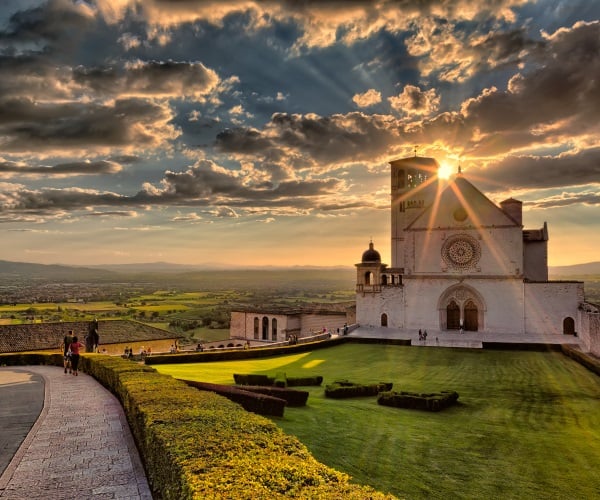 There are spots in Umbria that can touch your soul in a unique way, with arguably some of the greatest views in the world with splendours rarely seen. With shorter distances and less traffic, Umbria is an easier region to navigate between cities by car. So, if you decide to discover Umbria put these nine spots on your must-visit list.
Perugia
The capital of the region is three thousand years old, refounded by the Etruscans on a pre-existing Umbrian settlement. The city was one of the major hubs of the highest political role in Etruria. After the era of Roman domination, Perugia witnessed the moment of its greatest splendour between the 11th and 13th centuries. It is during this period that the majority of its most representative monuments and landmarks were built.
There are spots in Umbria that can touch your soul in a unique way, with arguably some of the greatest views in the world with splendours rarely seen. With shorter distances and less traffic, Umbria is an easier region to navigate between cities by car. So, if you decide to discover Umbria put these nine spots on your must-visit list.
Perugia
The capital of the region is three thousand years old, refounded by the Etruscans on a pre-existing Umbrian settlement. The city was one of the major hubs of the highest political role in Etruria. After the era of Roman domination, Perugia witnessed the moment of its greatest splendour between the 11th and 13th centuries. It is during this period that the majority of its most representative monuments and landmarks were built.
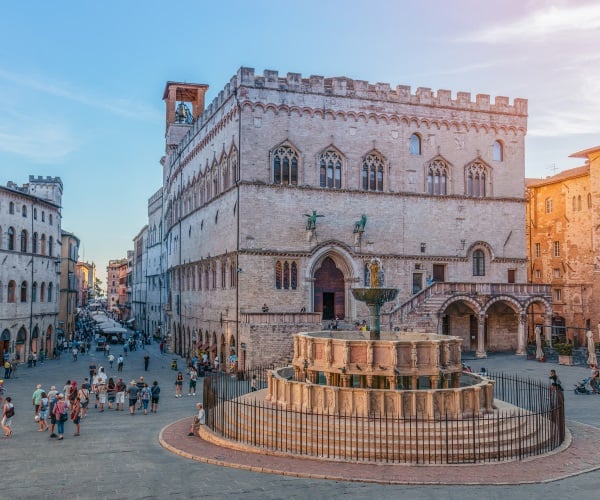 The main itineraries for visitors include the historic centre set within the Etruscan walls, the Cathedral, and the frescoes by the Italian Renaissance painter Perugino. The underground Rocca Paolina, built during the mid-16th century under the Papal State, is truly spectacular. Not to be missed is also the National Gallery of Umbria, which houses the largest collection of Umbrian artworks including paintings of Il Pinturicchio and Il Perugino as well as other works of art dating back to the period that goes from the thirteenth to the nineteenth century.
Assisi
Standing there, you’ll actually feel frozen in time. Assisi is probably the most important artistic, cultural, and religious Italian destination. This charming medieval town features all the characteristics of an Umbrian borgo: perched on top of a hill overlooking the valley, of small dimensions and still keeping its authenticity over the centuries.
The main itineraries for visitors include the historic centre set within the Etruscan walls, the Cathedral, and the frescoes by the Italian Renaissance painter Perugino. The underground Rocca Paolina, built during the mid-16th century under the Papal State, is truly spectacular. Not to be missed is also the National Gallery of Umbria, which houses the largest collection of Umbrian artworks including paintings of Il Pinturicchio and Il Perugino as well as other works of art dating back to the period that goes from the thirteenth to the nineteenth century.
Assisi
Standing there, you’ll actually feel frozen in time. Assisi is probably the most important artistic, cultural, and religious Italian destination. This charming medieval town features all the characteristics of an Umbrian borgo: perched on top of a hill overlooking the valley, of small dimensions and still keeping its authenticity over the centuries.
 Assisi is possibly the most popular village in Umbria attracting the greatest number of tourists by far, thanks to its most famous citizen Saint Francis. For this reason, Assisi played a fundamental role in the history of the world. It is here that the patron saint of Italy, Saint Francis, received his call and set off in order to reform the Catholic Church (or at least he tried to). Not to be missed: the Basilica of San Francesco, the Basilica of Santa Maria degli Angeli, the Temple of Minerva, dating back to the 1st century BC, and the Rocca Maggiore. Along the narrow streets of the centre, in addition to the souvenir shops, you will find cozy restaurants, tea rooms, and shops with Umbrian delicacies.
Gubbio
Driving toward the northern side of the region you will reach the delightful medieval town of Gubbio. It will be hard to forget the incredible views from the Piazza Grande, Gubbio’s main square, a large open space flanked by the medieval Palazzo dei Consoli and by the Palazzo del Podestà.
Assisi is possibly the most popular village in Umbria attracting the greatest number of tourists by far, thanks to its most famous citizen Saint Francis. For this reason, Assisi played a fundamental role in the history of the world. It is here that the patron saint of Italy, Saint Francis, received his call and set off in order to reform the Catholic Church (or at least he tried to). Not to be missed: the Basilica of San Francesco, the Basilica of Santa Maria degli Angeli, the Temple of Minerva, dating back to the 1st century BC, and the Rocca Maggiore. Along the narrow streets of the centre, in addition to the souvenir shops, you will find cozy restaurants, tea rooms, and shops with Umbrian delicacies.
Gubbio
Driving toward the northern side of the region you will reach the delightful medieval town of Gubbio. It will be hard to forget the incredible views from the Piazza Grande, Gubbio’s main square, a large open space flanked by the medieval Palazzo dei Consoli and by the Palazzo del Podestà.
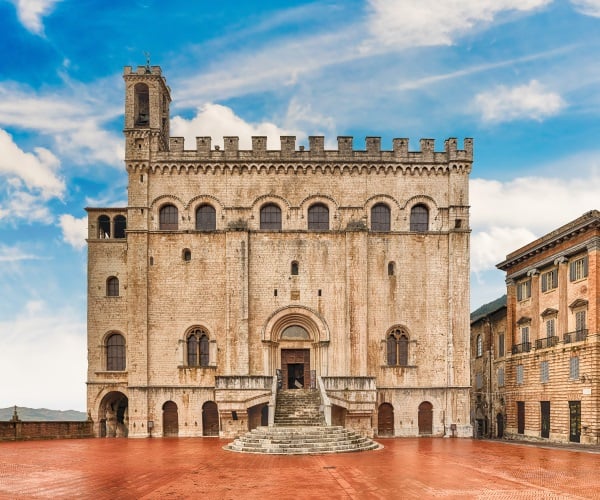 Once in Gubbio, visit the ruins of the ancient Roman theatre, you will step back in time to when the land belonged to the Roman Empire. Gubbio is also the best place to taste delicious Umbrian recipes with truffles.
Spoleto
Spoleto is perhaps the most distinctive of the small Umbrian medieval capitals. Partly because its name is related to a world-renown international event, the Festival dei Due Mondi, and also for the unique square hosting the event. Long and triangular in shape the square hosting the event opens onto the facade of the Cathedral, an absolute masterpiece of Romanesque art.
Once in Gubbio, visit the ruins of the ancient Roman theatre, you will step back in time to when the land belonged to the Roman Empire. Gubbio is also the best place to taste delicious Umbrian recipes with truffles.
Spoleto
Spoleto is perhaps the most distinctive of the small Umbrian medieval capitals. Partly because its name is related to a world-renown international event, the Festival dei Due Mondi, and also for the unique square hosting the event. Long and triangular in shape the square hosting the event opens onto the facade of the Cathedral, an absolute masterpiece of Romanesque art.
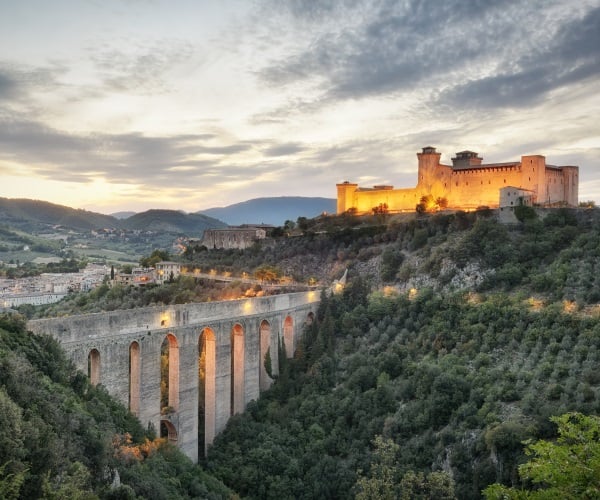 Spoleto is also well known for the Albornoz fortress that dominates the city, and for a grandiose bridge, the Ponte delle Torri, built as an aqueduct around the thirteenth century.
Orvieto
Set in a spectacular position, on a spur of tufaceous rock overlooking the valley, the glimpse of the upper town alone is able to excite and leave an unforgettable memory to its visitors. The magnificent, richly decorated Renaissance cathedral is one of the most beautiful sacred buildings in Italy with its magnificent portals and bas-reliefs adorning the facade.
Spoleto is also well known for the Albornoz fortress that dominates the city, and for a grandiose bridge, the Ponte delle Torri, built as an aqueduct around the thirteenth century.
Orvieto
Set in a spectacular position, on a spur of tufaceous rock overlooking the valley, the glimpse of the upper town alone is able to excite and leave an unforgettable memory to its visitors. The magnificent, richly decorated Renaissance cathedral is one of the most beautiful sacred buildings in Italy with its magnificent portals and bas-reliefs adorning the facade.
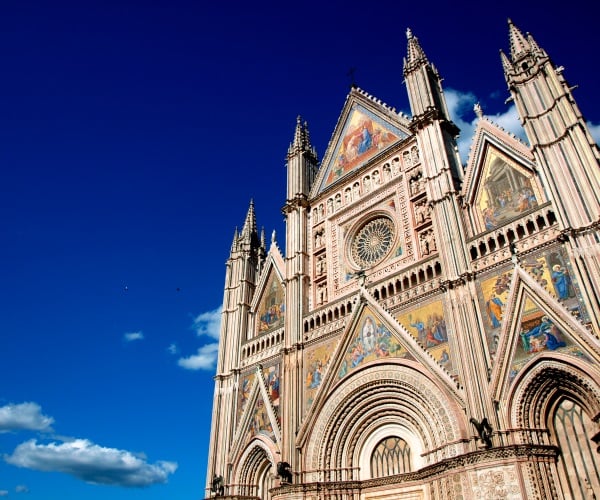 A real gem is the sixteenth-century well of San Patrizio, which descends with two helical staircases into the city underground for over 60 meters. Conceived as a source of water supply in case of sieges, it has now become a leading tourist attraction. Under the ground of Orvieto there is a labyrinth of caves and tunnels dug over the course of 2500 years and partly open to visitors.
Todi
Another fascinating example of a medieval historic town perched on a steep hill, Todi even has a sloping main square: the magnificent Piazza del Popolo overlooked by the Palazzo del Popolo, the Palazzo del Capitano, the Duomo and the Pinacoteca. A stylistic and architectural continuum of great charm, to admire during any season.
A real gem is the sixteenth-century well of San Patrizio, which descends with two helical staircases into the city underground for over 60 meters. Conceived as a source of water supply in case of sieges, it has now become a leading tourist attraction. Under the ground of Orvieto there is a labyrinth of caves and tunnels dug over the course of 2500 years and partly open to visitors.
Todi
Another fascinating example of a medieval historic town perched on a steep hill, Todi even has a sloping main square: the magnificent Piazza del Popolo overlooked by the Palazzo del Popolo, the Palazzo del Capitano, the Duomo and the Pinacoteca. A stylistic and architectural continuum of great charm, to admire during any season.
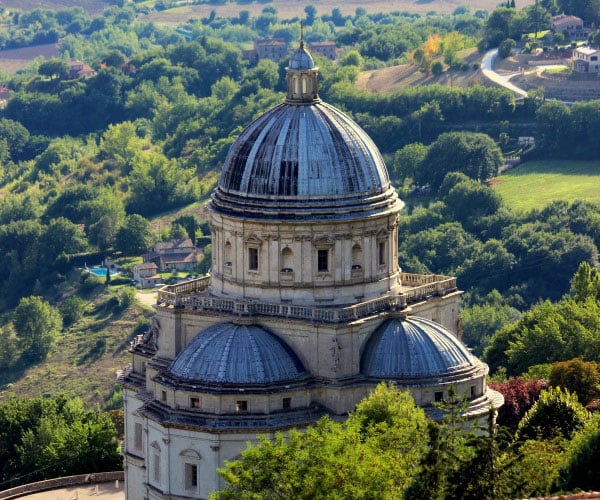 On the outer edge of the walls, it is possible to admire the white church of S. Maria della Consolazione, one of the greatest expressions of Renaissance architecture in Umbria, designed by Bramante in the early 15th century.
Montefalco
There are main reasons to explore this town perched on a hill and positioned around its main square overlooked by the elegantly arcaded Palazzo del Comune and several restaurants. The first one is purely artistic: in the former church of Saint Francis, now a museum complex, it is possible to admire the frescoes by Benozzo Bozzoli (1452), some of the greatest examples of Renaissance pictorial art.
On the outer edge of the walls, it is possible to admire the white church of S. Maria della Consolazione, one of the greatest expressions of Renaissance architecture in Umbria, designed by Bramante in the early 15th century.
Montefalco
There are main reasons to explore this town perched on a hill and positioned around its main square overlooked by the elegantly arcaded Palazzo del Comune and several restaurants. The first one is purely artistic: in the former church of Saint Francis, now a museum complex, it is possible to admire the frescoes by Benozzo Bozzoli (1452), some of the greatest examples of Renaissance pictorial art.
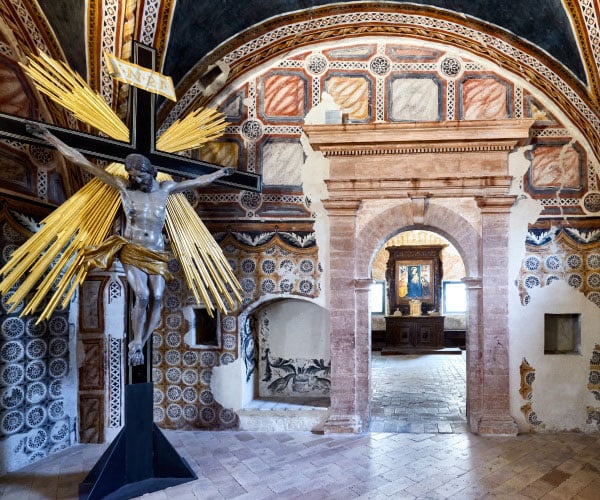 The second reason is the discovery of the Sagrantino, a typical vine of this area used to produce the homonymous doc. Two versions of Sagrantino are available, dry or passito, and the red Montefalco, made with Sangiovese and Sagrantino grapes.
Spello
Strolling along the main street of Spello setting off from the base of the town, you can visually retrace the history of a place and step back in ancient Roman, medieval, and Renaissance times.
The Consular gate, of Roman origin, is flanked by a medieval tower. On the top of the tower stands an olive tree, a symbol of peace and of the most typical local product, olive oil.
The second reason is the discovery of the Sagrantino, a typical vine of this area used to produce the homonymous doc. Two versions of Sagrantino are available, dry or passito, and the red Montefalco, made with Sangiovese and Sagrantino grapes.
Spello
Strolling along the main street of Spello setting off from the base of the town, you can visually retrace the history of a place and step back in ancient Roman, medieval, and Renaissance times.
The Consular gate, of Roman origin, is flanked by a medieval tower. On the top of the tower stands an olive tree, a symbol of peace and of the most typical local product, olive oil.
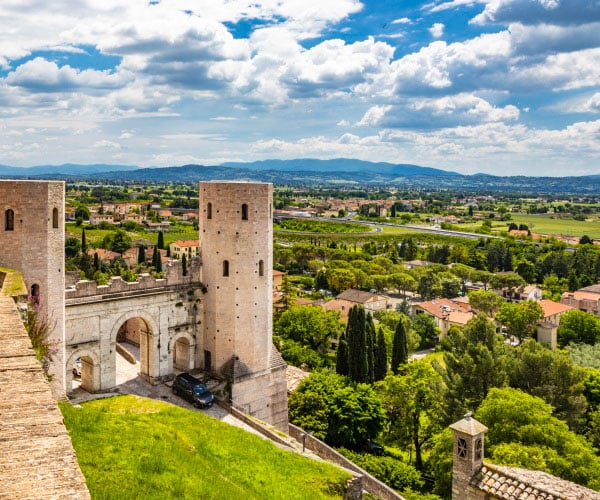 Later in the twelfth century, Spello became an independent municipality and experienced an era of intense artistic activity. During this period, the town was enriched with Renaissance masterpieces by Pinturicchio and Perugino. Spello overlooks the marvellous Umbrian plain and is surrounded by centuries-old olive groves from whose plants a precious and high-quality oil is obtained. Walking along the main street, you can stop for a meal in one of the excellent restaurants, or for a taste of excellent Umbrian wines accompanied by tasty regional cold cuts.
Lake Trasimeno
Punctuated by quaint medieval villages, outstanding sunsets reflected by its waters, put Trasimeno lake on your must-visit list. The green region of Umbria is an authentic paradise for all those who love to experience outdoor activities, the lake area is probably the best spot to enjoy sun-filled active days immersed in nature.
Later in the twelfth century, Spello became an independent municipality and experienced an era of intense artistic activity. During this period, the town was enriched with Renaissance masterpieces by Pinturicchio and Perugino. Spello overlooks the marvellous Umbrian plain and is surrounded by centuries-old olive groves from whose plants a precious and high-quality oil is obtained. Walking along the main street, you can stop for a meal in one of the excellent restaurants, or for a taste of excellent Umbrian wines accompanied by tasty regional cold cuts.
Lake Trasimeno
Punctuated by quaint medieval villages, outstanding sunsets reflected by its waters, put Trasimeno lake on your must-visit list. The green region of Umbria is an authentic paradise for all those who love to experience outdoor activities, the lake area is probably the best spot to enjoy sun-filled active days immersed in nature.
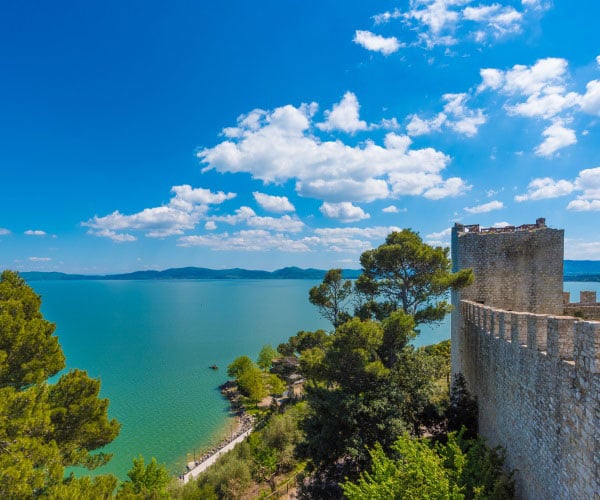 Not far from Perugia, the lake is a large body of still and very shallow water, with three islands in the centre, and small charming villages on the shores such as Castiglione del Lago. Enjoy an aperitif at sunset at Acqua Dolce Lounge Bar. Located in the village of Monte del Lago, in a beautiful panoramic position right in front of the lake, this aperitif bar overlooks the Polvese island offering a stunning spot for the golden hour.
Daniela De Luca is CEO at Home in Italy. Home in Italy is a luxury villa rental company offering high end holiday villa experiences throughout the best regions of Italy since 1993.
If you would like to be a guest blogger on A Luxury Travel Blog in order to raise your profile, please contact us.
Not far from Perugia, the lake is a large body of still and very shallow water, with three islands in the centre, and small charming villages on the shores such as Castiglione del Lago. Enjoy an aperitif at sunset at Acqua Dolce Lounge Bar. Located in the village of Monte del Lago, in a beautiful panoramic position right in front of the lake, this aperitif bar overlooks the Polvese island offering a stunning spot for the golden hour.
Daniela De Luca is CEO at Home in Italy. Home in Italy is a luxury villa rental company offering high end holiday villa experiences throughout the best regions of Italy since 1993.
If you would like to be a guest blogger on A Luxury Travel Blog in order to raise your profile, please contact us.Did you enjoy this article?
Receive similar content direct to your inbox.


We are in need of a new Tuscany. There was a time when Tuscany was getting overrun by the Brits. The pandemic may just have saved it.
Let’s hope that Umbria can still remain something of a secret destination and retain its original charms.
I hadn’t realised that Umbria was this rich in architectural gems.
We can easily say Umbria is Tuscany’s overlooked little sister. This region has so much to offer to discerning travellers interested in experiencing Italian art, history, culture and cuisine away from the crowds!